

Basic Chi-Gung Set for Daily Practice
The best way to learn chi-gung is under the close supervision of a qualified teacher, especially in the more advanced stages of practice, where incorrect form and wrong ideas can completely undermine one’s practice and even lead to deviations. On the other hand, it’s better to learn from a book, or not at all, than from a bad teacher.
The basic chi-gung set introduced below may be learned and practised from the instructions and illustrations provided in this book, without personal supervision from a teacher and without risk of experiencing harmful results or developing poor practice habits, as long as you observe the principles and precautions presented in earlier chapters and carefully follow the instructions given with each exercise. In chi-gung, it’s not the degree of complexity that counts for results, but rather one’s persistence and diligence in daily practice. Even the most elementary exercises can bestow profound benefits if practised daily and with presence of mind. Indeed, just one simple set can bring deeper, swifter results than the most complicated advanced forms, if that set is practised regularly and sincerely, for the benefits of chi-gung practice are cumulative, and they compound with the time and effort invested.
The set given below includes both moving and still forms. These may be practised together or separately. For example, you might start a session with the moving exercises, and finish with a period of still meditation, or practise the moving set in the morning and the still form in the afternoon or evening. Both moving and still forms are important in chi-gung, and it’s always best to combine some of each in any chi-gung programme, for while they both work with the same basic energy, each has its own particular virtues. Moving meditation, which is performed in a standing posture, opens up and replenishes all of the circuits of the Eight Extraordinary Channels. Known as the Macrocosmic Orbit (Fig. 18), these channels serve as general reservoirs of energy for the entire system, feeding chi as needed into the twelve organ meridians and all the subsidiary capillaries and providing power to the arms and legs. In terms of internal alchemy, the moving forms work mainly with essence and energy.
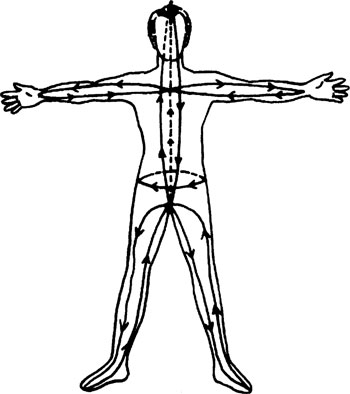
Fig. 18 The ‘Macrocosmic Orbit’: energy circulates internally to every part of the body via the ‘Eight Extraordinary Channels’ (chi-jing ba-mai)
Still forms work more with the higher energy centres and focus mainly on energy and spirit. The main circuit in still practice is the Microcosmic Orbit (Fig. 19), which channels lower energies from the sacrum up the spine into the head for refinement and transformation into spiritual vitality, then guides it back down the front of the body to the lower abdomen for storage. Thus the two styles of practice complement one another. If practised back to back, it’s best to start with the moving set and conclude with the still.
The best time of day to practise chi-gung is early in the morning, before breakfast. This is the period when Yang energy peaks in the atmosphere, and therefore practising during these hours brings in a much richer harvest of chi than at any other time. Practising in the morning is also a good way to tune up your whole system – body, energy and mind – for the entire day. The next best time is late evening, around midnight, when Yin switches over to Yang, and the third time is late afternoon, before dinner. Note that while practising in the morning perks you up and stimulates your energy, the same set of exercises practised late at night will calm you down and prepare your system for sleep. That’s because chi-gung always works in accordance with the overall prevailing energy conditions, internally as well as externally. At night, the body’s biorhythms are ready for sleep, so chi-gung works within that context. In the morning, energy is on the rise in the body as well as in the atmosphere, so chi-gung catches that wave. If you decide to separate your moving and still practices, then it’s best to do the moving set in the morning and the still work at night.

Fig. 19 The ‘Microcosmic Orbit’: energy circulates internally between the Upper Elixir Field in the head and the Lower Elixir Field in the abdomen, via the Conception (front) and Governing (back) Channels, transforming at various ‘power points’ along these two channels
Moving Meditation Set
The exercises introduced below have been carefully selected to provide balanced benefits for body, breath and mind and to bring all three into harmony with each other and with external energy fields. If you have the time and inclination to practise the full set every day, that will of course provide the best results but it is not necessary to do the entire series each and every time you practise. If you’re pressed for time or feeling fatigued, simply select a few exercises from each of the three stages and just do those. However, do not practise only one stage, such as the main set, at the expense of the warm-up and collection sets. In order to achieve optimum results, maintain proper balance throughout the system, and prevent deviations, it’s very important always to practise moving chi-gung exercises in the three-stage format suggested here – preliminary warm-up, main mobilization practice, and final collection and storage stage. Even if you only do one exercise from each stage, do them in the prescribed order.
When practising this set, it’s best to follow the sequential order in which the exercises are presented, even if you only select a few of them. They are arranged in such a way that each exercise builds on the results of the previous one and leads naturally into the next. Try this set as it is for about six months of daily practice, after which you may wish to rearrange your chi-gung programme according to your own requirements and interests. There are many different chi-gung exercises introduced in The Tao of Health, Sex, and Longevity and The Complete Book of Chinese Health and Healing, and any of them may be added to or substituted for the exercises in the set given below. Chi-gung changes your body and transforms your energy and eventually it transforms your mind as well, so you should always remain flexible with your practice. From time to time, you should experiment with different exercises and forms, and amend your daily set every six months to a year, but always be sure to follow the basic principles, and practise in the three-stage format given here.
If weather and other circumstances permit, practise barefoot in a garden. If a garden is not available, then practise out on a terrace, on top of a building or, if necessary, by an open window. It’s not a good idea to practise chi-gung in a closed room with air-conditioning or central heating.
Warm-Up: Balancing Body, Breath, and Mind for Practice
The first stage of preparation for the main practice is to balance the body by stretching muscles and tendons, loosening joints and vertebrae, and releasing all physical tension. These exercises also stimulate circulation, activate the endocrine system, and open up the energy channels, thereby establishing a strong foundation for the main practice.
Spinal Twist (Fig. 20)
Method: Stand in the Horse, with shoulders completely relaxed and arms hanging loosely at the sides, knees unlocked. Start turning slowly from left to right, using only the thighs for power, and letting the waist, torso and arms follow naturally, turning with the torque produced by the legs. Keep the elbows loose and unlocked, so that the arms flail freely out to the sides on each turn, and let the hands slap against chest and back as each turn is completed. Keep the spine and neck erect, and turn the head around on each turn so that you can see over the back of each shoulder. Gradually increase the extent of each twist until you’ve reached your limit of flex and keep the entire exercise slow, gentle and rhythmic. Do 3 to 4 dozen turns, or 3 to 5 minutes of practice.
Benefits: This manoeuvre realigns and balances all of the spinal vertebrae from neck to sacrum, stretches and tones all of the muscles along the spine, and stimulates all of the nerves and peripheral branches of the spinal cord. The spine is the central pillar of chi-gung practice and the ‘Stairway to Heaven’ for energy to ascend from sacrum to head, so any tension, blockage or misalignment in the bones, muscles or nerves of the spine is a serious impediment to practice. This exercise is probably the most important in the entire warm-up set, and may be practised any time of day or night for a quick spinal realignment and recharge.
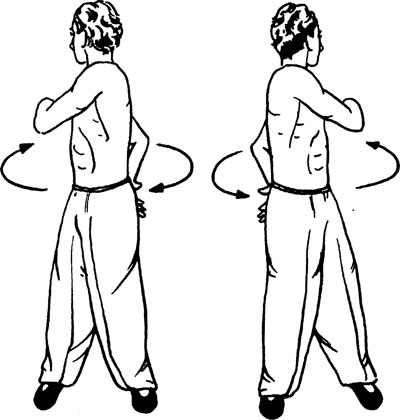
Fig. 20 The Spinal Twist: the most important warm-up exercise for chi-gung
This exercise also opens the ribcage and stretches the diaphragm in preparation for deep abdominal breathing, massages the organs, glands and other tissues in the abdominal and sacral cavities, and helps loosen the shoulders and neck.
Wide Hip and Thigh Squats (Fig. 21)
Method: Adopt an extra-wide stance, with feet splayed out at 45 degrees and hands firmly planted at the waist, as shown in the illustration. Keeping the back as straight as possible and head up, squat down slowly as far as you can without losing your balance or causing excessive strain, then rise back up again, slowly, until the knees are straight. Try not to bend forward as you squat down, for that negates the stretch to the thighs. Repeat 6 to 10 times.
Benefits: Wide squats give a deep stretch to the tough tendons, large muscles and major arteries on the inside of the thighs, which tend to tighten up and block circulation. These squats also open up the leg channels of the Macrocosmic Orbit and tone the urogenital diaphragm. Practising the anal sphincter lock as you squat down is an excellent way to strengthen the entire pelvic floor, prevent and cure haemorrhoids, and stimulate sacral gland secretions. This exercise also builds strong legs, which are the supporting columns of all practices done in the Horse stance.
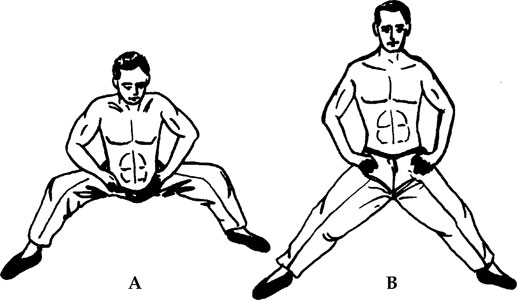
Fig. 21 Wide hip and thigh squats:
A. Squat down in wide stance
B. Rise up and straighten knees
Back Bows (Fig. 22)
Method: Spread feet a bit more than shoulder-width apart and place hands out on the ground in front, so that the body forms an upside-down ‘V’ shape, with legs and arms fully extended and spine arched up. Lean forward on the hands and let the hips drop down toward the ground as you also bow the spine and raise the head up and back. Then push up the body again and arch the spine, letting the head drop down and hang loosely between the arms. Repeat 12 to 15 times.
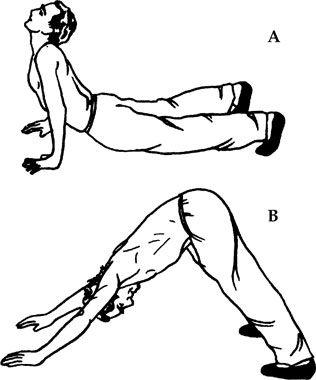
Fig. 22 Back bows:
A. Lean forward on arms and bow the back
B. Push upward on hands and arch the back
Benefits: This exercise stretches the entire spinal cord length-wise, rather than from side to side, and further realigns the vertebrae. It also tones the spinal muscles and stimulates the nerves of the spinal cord. The alternate expansion and contraction of the front and back of the body opens the channels of the Microcosmic Orbit and stretches the ribs and diaphragm in preparation for deep breathing. The bobbing up and down of the head promotes circulation to the brain. This exercise also builds strength in the shoulders, arms and legs.
Note: If you find that your upper body strength is insufficient for this exercise, or if you have a back problem that precludes doing it, you may either delete this exercise from your set, or else substitute the ‘Spinal Stretch’ exercise suggested as a warm-up for still meditation in the next section (see Fig. 45).
Pelvic Thrust and Pelvic Rotation (Fig. 23, A and B)
Method:
• Pelvic Thrust. Stand in Horse, with knees unlocked and hands planted firmly on hips. As you inhale through the nose, tilt the pelvis back as far as possible, so that the buttocks stick out at the back, then exhale through the mouth and tilt the pelvis forward as far as possible, straightening the curve in the lower spine. Repeat 6 to12 times, slowly.
• Pelvic Rotation. Keeping hands on hips, rotate the entire pelvis in wide circles, letting the upper torso bend in the opposite direction for balance. Inscribe as wide an arc as possible as you rotate. Do 6 to12 rotations in one direction, then in the opposite direction, and finally back in the original direction.
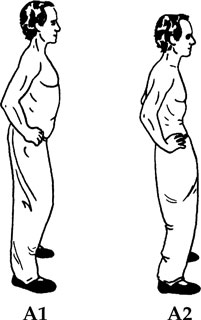
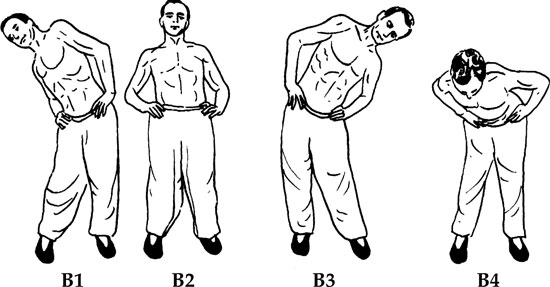
Fig. 23 Pelvic thrust (A) and pelvic rotation (B):
A-1. Tilt pelvis back while inhaling
A-2. Tilt pelvis forward while exhaling
B-1. Rotate pelvis to left and lean torso to right
B-2. Rotate pelvis forward and lean torso back
B-3. Rotate pelvis to right and lean torso to left
B-4. Rotate pelvis back and lean torso forward
Benefits: These two exercises stimulate all of the nerve endings and glands in the sacral region, balancing endocrine secretions and activating the pneumogastric nerves of the parasympathetic branch of the autonomous nervous system. This is excellent therapy for menstrual disorders in women and deficiency of sexual secretions and sexual energy in both men and women. It limbers the lumbar vertebrae and opens up the energy centres along the lower spine and abdomen. The rotations also provide a stimulating massage to the lower bowels, thereby helping prevent constipation and enhancing peristalsis.
Abdominal Lift (Fig. 24)
Method: Stand somewhat pigeon-toed, knees bent and lean forward so that you can place the palms of your hands on the inside of the thighs, just above the knees, and fully support the weight of your upper body by leaning onto your arms. Forcefully expel your breath so lungs are completely empty, then apply the neck lock to prevent any air from re-entering the lungs. With a strong, deliberate contraction, pull the entire abdominal wall in toward the spine, pushing the internal organs and the diaphragm up into the chest cavity. Hold for about 5 seconds, then relax the abdominal wall, let the organs and diaphragm descend again, release the neck lock, and inhale deeply. Repeat 3 times.
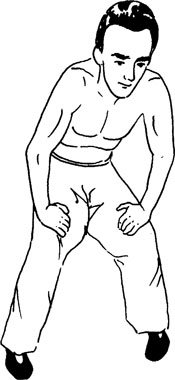
Fig. 24 The Abdominal Lift: exhale completely, then draw abdominal wall inward and upward as far as possible
Benefits: This is an excellent way to prepare your breathing apparatus for deep diaphragmic breathing, especially in the beginning stages of practice, when the diaphragm is still stiff. It loosens and relaxes the diaphragm, improving its flex and developing voluntary control over its movement. The deep contraction of the abdomen squeezes stale blood from the internal organs and glands, and the relaxation phase then allows freshly oxygenated blood to flood in and replenish these tissues. It gives a strong boost to circulation by exerting pressure on the vena cava, prevents constipation, relieves gastritis and clears any sort of congestion in the digestive organs.
Side Stretch (Fig. 25)
Method. Stand in the Horse and raise both hands straight up above the head, then clasp fingers together and turn the palms up to face the sky. Stretch up as far as possible by pushing the palms towards the sky, then slowly tilt the entire upper body to one side as you exhale, so that the other side is stretched open. Keep tilting to the side until you’ve reached your limit of flex and the lungs are empty, then slowly straighten up again while inhaling. Next, tilt as far as possible in the opposite direction as you exhale. Repeat 3 times on each side.
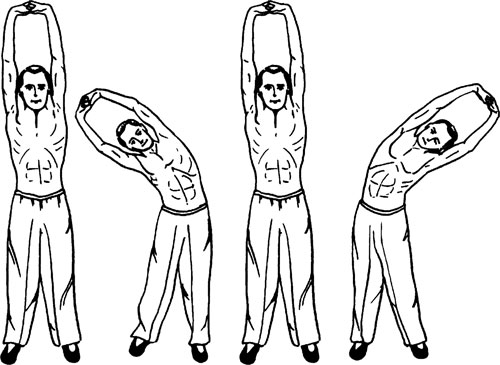
Fig. 25 Side Stretch: clasp hands and stretch arms to the sky; exhale while stretching to right; inhale while returning to upright posture; exhale while stretching to left
Benefits: Opens up the entire chest cavity in preparation for deep abdominal breathing. Tilting to the side alternately expands and contracts both sides of the lungs and opens up energy circulation in the meridians that run along the sides of the torso and into the arms. Also helps realign the spinal vertebrae and tone the spinal muscles.
Wing Tip Flex (Fig. 26)
Method: Stand in Horse and raise arms out to the sides, with hollows of the elbows facing up towards the sky and palms towards the ground. Extend the index and middle fingers, while holding the other two fingers against the palm with the thumb. Stretch hands upward from the wrists, so that index and middle fingers are pointing to sky, then stretch them downward so that fingers point to the ground. Continue flexing up and down about two dozen times, bending hands from the wrists as far as possible in both directions.
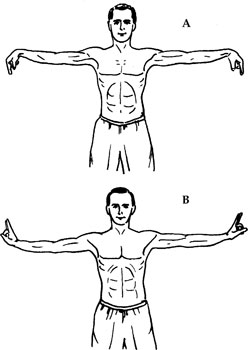
Fig. 26 Wing Tip Flex:
A. Flex wrists down and point fingers to the ground
B. Flex wrists up and point fingers to the sky
Benefits: This exercise opens up the energy channels that run through the arms from shoulders to hands, stimulating and balancing the flow of energy through them, and drawing energy into the hands. It also stretches and tones the tendons and nerves that run from the hands to the elbows and shoulders.
Shoulder Rolls (Fig. 27)
Method: Roll the shoulders forward, then raise them up towards the ears, then back as far as possible, down and around to the front again, inscribing as wide an arc as possible. Try to keep the shoulder and arm muscles loose as you roll the shoulders around in their sockets. Do 6 to 12 rolls backwards, then another 6 to 12 forward in the opposite direction.
Benefits: Opens up the whole chest in preparation for deep breathing, while also loosening the shoulders and releasing tension in the muscles of the upper back. Tension in the upper back and shoulders blocks the free flow of energy during chi-gung practice, and this exercise is designed to prevent that.
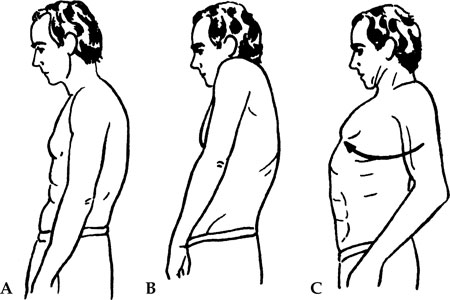
Fig. 27 Shoulder Rolls:
A. Roll shoulders forward
B. Roll shoulders upward
C. Roll shoulders back, then roll them down and forward again
Neck and Throat Stretch (Fig. 28, A and B)
Method: Raise the head up and tilt it back as far as possible, thereby compressing the back of the neck. Slowly and gently tilt the head from side to side, going only as far as your flexibility permits without causing pain. After turning 5 to 6 times to each side, return head to centre, raise head slowly back to normal position, and continue tilting forward until head is hanging down in front, chin to chest. Slowly turn from side to side, until you can see over each shoulder, 5 to 6 times to each side, then return to centre position and slowly raise head back to normal position.

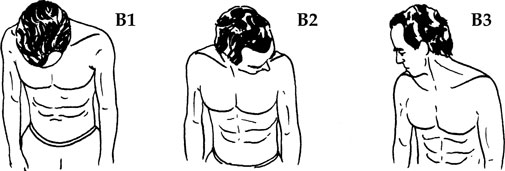
Fig. 28 Neck and Throat Stretch:
A-1. Tilt head up and back
A-2. Turn head to left
A-3. Turn head to right
B-1. Tilt head forward and down
B-2. Turn head to left
B-3. Turn head to right
Benefits: This exercise stretches and compresses both the back and front of the neck, opens up the throat, loosens the cervical vertebrae, and releases tension from the muscles and tendons of the neck. If the neck is tense, as is so common these days due to chronic tension, it becomes a ‘bottleneck’ during chi-gung practice, obstructing the flow of energy into and out of the head. A lot of toxins and stagnant energy also get trapped in the neck, and this exercise loosens and clears them away prior to the main practice.
Neck Knead (Fig. 29)
Method: Clasp the hands behind the head, so that the thumbs are free to knead the muscles and tendons along the back of the neck and upper shoulders. Use the thumbs to massage deeply into the muscular cords on both sides of the cervical vertebrae, from the top of the shoulders up to the base of the skull. Knead as deeply as possible, rubbing in circles as you press into the tissues. Use the thumbs to locate the two ‘Wind Pond’ points located at the base of the skull, where the neck enters the head, and press deeply on them several times.
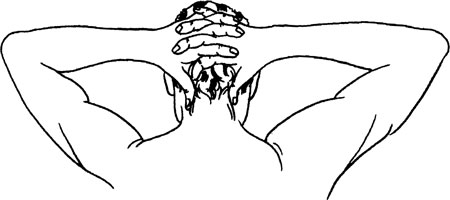
Fig. 29 Neck Knead
Benefits: This is another effective way to release tension from the muscles and tendons of the neck and shoulders, loosening and clearing stagnant energy and toxic fluids from the neck, opening up the energy channels that run from the spine into the head, and stimulating energy to ascend up the spine. Also stimulates and balances the nerves in the neck and helps align the cervical vertebrae.
The Three Taps (Fig. 30, A, B, and C)
The three taps and their benefits have already been discussed (see “Working with Touch,” chapter 6). When performed in preparation for chi-gung practice, the head tap (pituitary and pineal), heart tap (thymus), and kidney tap (adrenal) stimulate secretions from these vital glands, thereby balancing the entire endocrine system and providing abundant supplies of potent hormone essence for conversion into energy during the main practice. This exercise enhances overall immune response, energizes the entire system with vibratory stimulation, and helps loosen impacted toxic wastes in the neck, brain, lungs and kidneys.
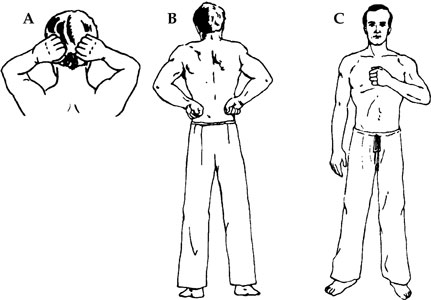
Fig. 30 The ‘Three Taps’:
A. Head tap (pituitary and pineal glands)
B. Kidney tap (adrenal glands)
C. Heart tap (thymus gland)
Tongue Stretch and Roll
Method: Open the mouth and stretch the tongue out as far as possible, then roll it back into the mouth and curl the tip up to the top of the throat. Repeat 3 to 5 times. Next, swirl the tongue around in circles between the external side of the gums and the inside of the lips and cheeks, running the tongue along the entire upper and lower ridges of the teeth. Continue for about one minute, or until saliva is secreted from the ducts beneath the tongue. This should be swallowed.
Benefits: The tongue is connected to the heart muscle, so stretching and rolling the tongue tonifies the heart muscle. It also stretches and tones the tongue and trachea in preparation for deep breathing, and stimulates secretion of beneficial saliva from the ducts beneath the tongue. Saliva from beneath the tongue is rich in highly beneficial enzymes, which assist digestion, soothe the stomach, and eliminate bad breath by breaking down the bacteria which cause it.
The second phase of the warm-up stage is to balance the breath, establish rhythmic harmony between body and breath, and attune the mind with the synchronized movements of body and breath. Here’s a simple three-step way to do this:
1. Stand in the Horse (see Fig. 11), with arms hanging loosely at the sides, and do about 2 minutes of incremental bellows breathing. This clears stagnant air from the lungs, loosens the diaphragm, stimulates the nasal and bronchial passages, and gives a strong boost to circulation of blood. It also opens up the channels of the internal energy circuits.
2. Next, do some alternate nostril breathing (see page 174), 6 on each side, to balance the flow of air through both nostrils, balance internal energy flow, and balance the functions of the right and left hemispheres of the brain.
3. Third, synchronize your breathing with the movement of your body by performing the breathing exercise known as ‘Opening the Energy Gates’, or ‘Body Breathing’ (Fig. 31). Inhale slowly through the nostrils and raise the arms slowly out to the sides, but only to about a 30- to 45-degree angle with the torso, then exhale and lower the arms slowly back down to the sides. Focus attention on the hands and on the lower abdomen, and try to make inhalation and exhalation even and long. In addition to synchronizing the movements of body and breath, this exercise also opens up the energy gates in the palms and at the lower elixir field just below the navel, inducing energy to flow through these gates along with the inflow and outflow of air in the lungs. While doing this exercise, focus your attention fully on the attunement of body and breath to bring your mind into balance with them. Body and breath move like partners in a slow dance, with breath leading and body following, and the mind serving as chaperone to keep them both in step.
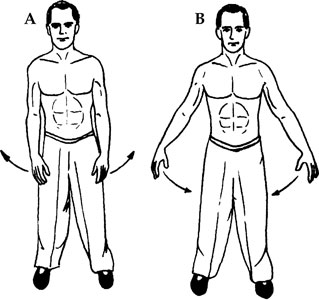
Fig. 31 ‘Opening the Energy Gates’:
A. Inhale deeply and raise arms slowly up and out to the sides
B. Exhale smoothly and lower arms back down to the thighs
Main Practice: Mobilizing, Circulating, and Balancing Energy
With body, breath and mind balanced and moving in harmony, you’re now ready to do the main practice, which involves a series of slow-motion body movements performed in conjunction with deep diaphragmic breathing. In between each exercise, you should perform three slow ‘Opening the Energy Gate’ breaths to draw energy collected in the previous exercise down into the lower elixir field in the abdomen and to prepare your energy system for the next exercise. During all of these exercises, keep your background attention focused on maintenance of proper posture and correct breathing, and focus the foreground of your awareness on the movement of energy through your system. You may wish to visualize energy as luminous light streaming in and out of various gates and flowing through your channels, or try to feel the energy moving through various parts of the body like currents of warm water. The more clearly you bring energy into conscious awareness, the more strongly it flows through your system. Whenever your mind wanders away from the practice, your energy follows it and dissipates, rather than concentrating in the channels and collecting in the energy centres. When properly practised with stable presence of mind, these exercises drive stagnant energy out of the system, draw fresh energy in through the energy gates, circulate and store energy in the reservoirs of the Eight Extraordinary Channels, distribute energy throughout the entire system, and balance energy in the elixir field centres (chakras).
Iron Bridge (Fig. 32)
This is a version adapted by the author from the classic Iron Bridge chi-gung exercise. It stimulates and balances energy flow between the front and back and the upper and lower parts of the body.
Method: Standing in the Horse, take a full inhalation, then start exhaling slowly through pursed lips in a long steady stream and bend forward slowly, starting from the coccyx and working along the spine, vertebrae by vertebrae, to the mid-back, shoulder area, and finally the neck, until you are bent over with arms dangling down loosely. Do this very slowly, even if it requires two breaths to complete the forward bend. Keep the knees unlocked and slightly bent throughout this phase of the exercise. While bent over forward with empty lungs, take a deep inhalation through the nose as you raise your head up as far as possible. Then exhale through the mouth while slowly lowering the head again. On the next inhalation, start rising up slowly, beginning at the lower back and working progressively up the spine to the neck and head.
Your body should return to its original erect posture just as inhalation is complete, but do not stop moving. Bring your hands around to the back and place the palms firmly on kidneys, then lean over backwards as you exhale slowly through pursed lips, using your arms as a brace to support your weight. Lean back as far as possible without causing discomfort, until exhalation is complete. Holding this position, take a long slow nasal inhalation, followed by a long slow mouth exhalation. As you commence the next inhalation, slowly straighten up your spine and raise your head up, then bring both hands up from the kidneys and raise them straight up over your head, with the palms facing each other. On completion of inhalation, stretch your arms up as high as possible, extending the stretch down through the shoulders and ribcage, apply the neck lock and briefly compress the breath down into the abdomen. Then relax the neck, release the breath and exhale in a long steady stream through the lips, while turning the palms outward and bringing the arms slowly down to the sides, timing the movement of arms so that exhalation is completed as the hands return to their original starting position. Repeat this cycle 6 times.
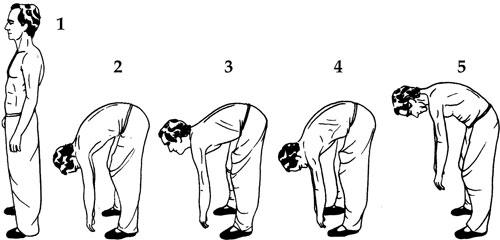
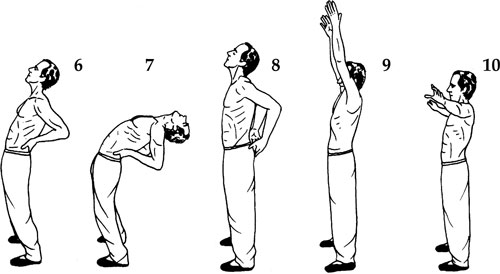
Fig. 32 The Iron Bridge:
1. Starting posture. 2. Exhale, lean forward, and bend down. 3. Inhale while bent forward and raise head up. 4. Exhale and slowly lower head down. 5. Inhale and rise up slowly. 6. When inhalation is complete, place palms firmly on kidneys and lean back slowly while exhaling. 7. Lean back as far as possible on completion of exhalation. 8. Inhale while rising slowly up and raise arms upward over head. 9. Stretch arms up towards sky as far as possible on completion of inhalation. 10. Exhale smoothly, relax shoulders completely and bring arms slowly down to the sides with palms down
Benefits: This exercise stretches and tones the entire spinal column, stimulates the flow and balances the distribution of cerebrospinal fluids, and draws energy into the channels of the Microcosmic Orbit. It also massages the kidneys and adrenal glands, tonifies kidney energy, and stimulates the thymus gland. It engages the entire chest cavity in breathing and flexes the diaphragm from the front and back, enhancing correct breathing technique. It also draws energy into circulation in the arm and leg channels and opens up the entire Macrocosmic Orbit. Raising and lowering the head in front and back while breathing deeply promotes abundant circulation of freshly oxygenated blood to the brain, and the long mouth exhalations purge the bloodstream of carbon dioxide and other wastes.
Palms Raised to Heaven to Regulate the Triple Burners (Fig. 33)
This exercise comes from the Eight Pieces of Brocade set (see discussion in chapter 9) developed by Marshal Yueh Fei during the Sung dynasty. It is designed to open up the valves and gates of the ‘Triple Burner’. The Upper Burner governs movement of energy and blood from the top of the throat to the entrance of the stomach, including lungs and heart; the Middle Burner regulates vital functions and energy flow in the major digestive organs from the stomach, spleen and pancreas, to the liver, gallbladder, kidneys and small intestine; the Lower Burner controls excretory orifices and their functions and distributes energy to the bowels and bladder. This exercise balances these three energy systems and regulates the various vital functions of the related organs.
Method: Stand in the Horse, empty the lungs and relax. Bring the hands together in front, palms up, fingers about an inch (2.5cm) apart. As you commence a long slow inhalation, slowly raise the hands up along the front of the body. When palms reach neck level, turn them around 360 degrees so that they face the sky again and continue raising them upward as you complete inhalation. Lungs should be full by the time hands reach forehead level. Compress the breath and apply the locks and continue raising the palms until your arms are fully extended above the head. Then relax the locks, release the breath and exhale slowly through the nostrils, while turning the palms out to the sides and bringing the arms slowly back down to the starting position. Turn palms upward and commence the next cycle. Repeat 12 times.
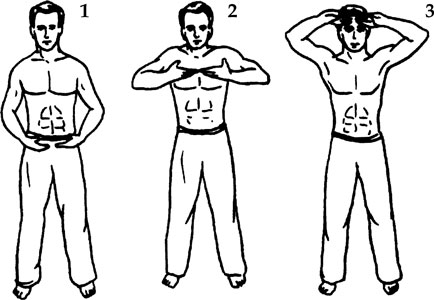
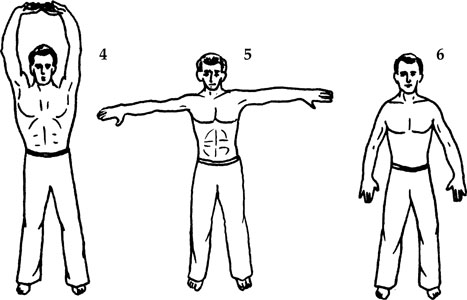
Fig. 33 Palms Raised to Heaven to Regulate the Triple Burners:
1. Starting posture. 2. Inhale and raise palms slowly up the front of the body. 3. Turn palms around to face upwards and continue raising them towards the sky while continuing inhalation. 4. Palms raised to heaven upon completion of inhalation. 5. Exhale smoothly and evenly while bringing arms slowly down to the sides. 6. Hands return to thighs upon completion of exhalation.
Benefits: This exercise balances energy in all of the internal organs and harmonizes their vital functions. The lungs and heart are brought into balance for optimum respiration and circulation, the kidneys and liver are stimulated to purify the bloodstream, all digestive functions are regulated, the excretory functions of the bladder and bowels are improved, and the endocrine system is balanced. Energy flow in the arm channels is activated, and the protective aura of Guardian Energy that envelopes the body is strengthened.
Shake the Head and Wag the Tail to Expel Fire from the Heart (Fig. 34)
This is another exercise from the Eight Pieces of Brocade set, simplified for easier practice. It drives excess Fire energy out of the system, clearing the channels for cooling Water energy converted internally from vital essence and drawn into the system from external sources.
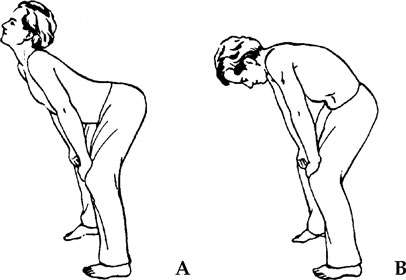
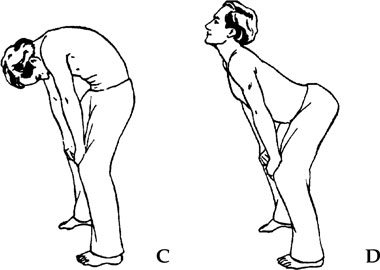
Fig. 34 Shake the Head and Wag the Tail to Expel Fire from the Heart:
A. Inhale slowly while bowing the spine and raising the head
B. Exhale through mouth while arching the spine, lowering the head and tucking the bottom inwards
C. Fully arch the spine and bend head down upon completion of exhalation
D. Inhale slowly while bowing the spine and raising the head
Method: Plant the feet wider than shoulder-width apart and splay the toes inward at about 45 degrees. Place the palms firmly on the thighs just above the knees, with fingers and thumbs pointing inward, and lean forward so that your weight is resting fully on your arms. As you inhale slowly and deeply, raise the head up and bend the neck back, while bowing the entire spine and sticking out the buttocks at the back, until you reach full extension. The abdominal and neck locks do not come into play in this exercise, but you may apply the anal lock as inhalation reaches completion.
Next, open the mouth and start exhaling slowly from the top of the throat, making a ‘haw’ sound. This sound draws excess Fire from the heart. While exhaling, bring the head down, tuck the buttocks in and arch the spine upward, until you reach full extension, with chin against chest and rounded back. Repeat 6 to 12 times.
Benefits: The alternate arching and bowing of the back align the vertebrae, tone the spinal muscles and stimulate the nerves of the spinal cord. It also provides strong stimulation to the adrenals and thymus gland. One of the major causes of chronic degenerative conditions today is what’s known in TCM as ‘excess Fire energy’. This is caused by poor diet, especially excessive consumption of acid-forming foods, incomplete digestion, alcohol and drugs, pollution and chronic stress. This exercise is designed to expel excess Fire from the system by drawing it out through the lungs and energy gates. At the same time, it stimulates the adrenal cortex to release hormone essence for conversion into cooling, restorative Water energy, thereby balancing Fire with Water and increasing immunity and resistance. This exercise also tones the diaphragm and deepens the breath.
Open the Chest and Stretch the Upper Spine (Fig. 35)
This exercise is based on one of the steps in the Eight Pieces of Brocade, but is much simpler to practise. It opens the heart chakra, stimulates the thymus gland and gives a deep stretch to the upper spine.
Method: Stand in the Horse and clasp your hands behind your back by intertwining the fingers. While slowly inhaling, rise up slowly on your toes and raise your clasped hands upward behind the back, but without bending the torso forward. The idea is to stretch the shoulders back as far as possible by raising the arms up in back, which also stretches open the entire front of the chest. When your lungs are full, release the breath and exhale through the nose, while slowly bringing the heels back down to the ground and lowering the arms down at the back. Since there is not much distance involved in these movements, they should be done very slowly to keep them in tune with the breath.
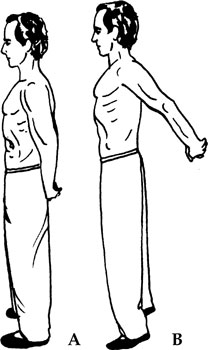
Fig. 35 Open the Chest and Stretch the Upper Spine:
A. Starting posture: Horse stance with hands clasped behind back
B. Inhale while slowly raising clasped hands upwards behind back and standing up on toes, then exhale and return to ‘A’ posture
Benefits: Stretches all the vertebrae of the upper spine and opens the whole chest cavity, while also toning the muscles of the calves. Opens the heart chakra and allows energy to flow freely through it. Standing up on the toes stimulates energy along the bladder meridians on the back of the legs, and the upper spine stretch extends that stimulation to the upper branches of the bladder meridian in the upper spine, neck and back of the head. This exercise also draws terrestrial energy up from the earth through the ‘Bubbling Spring’ points on the soles, and brings it up the back of the legs to the spine and into the head on inhalation, then draws it back down the front of the body on exhalation. In addition, it helps develop physical coordination and balance.
Embracing the Tree (Fig. 36)
This is a still standing exercise designed to activate the internal flow of energy through the channels of the Macrocosmic Orbit. It also condenses energy in the channels and develops conscious awareness of energy moving in the body.
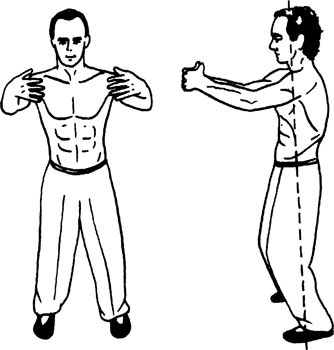
Fig. 36 Embracing the Tree: front and side views; note the alignment of the Upper (head), Middle (solar plexus) and Lower (abdomen) Elixir Fields with the centre line between the balls of the feet
Method: Stand in the Horse, with the feet perfectly parallel. Rub the palms briskly together to charge them with chi. Inhale and slowly raise your arms up in front of your body. When arms are extended in front of the solar plexus, turn the palms so that they face the heart and hold the arms as if they were embracing a large round tree. Maintaining correct posture is very important here: straight spine aligned with neck and head, buttocks tucked in, shoulders relaxed, and weight resting on the balls of the feet, not on the heels. Breathe consciously in the four stages and use the three locks, while focusing attention on the feelings in your hands, arms and anywhere else that you detect energy moving. Try to maintain balanced posture and stable stance with minimal muscular tension. Continue ‘embracing the tree’ and breathing deeply from the diaphragm for 5 to 10 minutes, or however long you can. Some adepts practise this exercise for up to an hour at a time.
Benefits: This exercise generates a strong flow of internal energy that runs through all of the Eight Extraordinary Channels of the Macrocosmic Orbit and stores reserve energy in these reservoirs. It beams energy through the lao-gung points of the palms into the heart chakra, and draws energy up from the earth through the yung-chuan points on the soles into the leg channels. It activates circulation in the Microcosmic Orbit, drawing sacral Fire energy up through the spinal passes to the head, cooling and refining it into Water, then sends it back down the front as Water energy. This exercise also develops a strong Horse stance, which is useful for all chi-gung practice, and cultivates proper posture in the spine.
Merging Heaven and Earth (Fig. 37)
Method: Stand in Horse, with arms hanging loosely by your sides. As you commence a long, slow inhalation, raise both arms slowly up in front, palms facing down, wrists and fingers completely relaxed, until arms are extended out in front, parallel to the ground, and inhalation is complete. Draw the hands in towards the chest, keeping palms facing downward, by bending the elbows, then commence a long, slow exhalation through the nose, while simultaneously pushing the hands down the front of the body toward the ground and gradually bending the knees. At the end of exhalation, hands are down in front of thighs, palms facing the ground and legs bent in a semi-squat. As you commence the next inhalation, extend the hands forward and then upward in a circular movement and straighten the knees, until arms are up in front parallel to ground on completion of inhalation, then draw the hands back in toward the body and push down again on exhalation. The idea of the exercise is to inscribe a large circle in front of the body with the hands, and to rise up and down on the knees, in synchrony with breath.
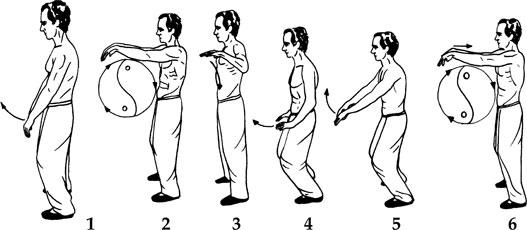
Fig. 37 Merging Heaven and Earth:
1. Starting posture: Horse stance, knees bent. 2. Inhale and raise arms up in front, with palms down, and straighten knees. 3. Draw arms back towards chest upon completion of inhalation. 4. Exhale while lowering palms down in front and bending knees. 5. Inhale, raise arms up in front and straighten knees. 6. Continue breathing while inscribing ‘Tai-Chi’ circle in front of body
Benefits: This exercise balances Yin and Yang, merges Heaven and Earth, and fuses Fire and Water, establishing polar equilibrium within the energy system. Terrestrial energy is drawn up through the energy gates in the soles and palms, while celestial energy is drawn down from the crown. The two merge and fuse at the chest on completion of inhalation and are packed down into the ‘Sea of Energy’ in the lower elixir field on exhalation. It’s a very good exercise for developing synchronized movement of body and breath, cultivating balance and physical coordination, and building strong thighs, knees and ankles. This exercise also helps establish and maintain emotional equilibrium and mental clarity.
Great Tai-Chi Circle (Fig. 38)
If you practise only one chi-gung exercise, this is the one to select. It completely opens and balances circulation of energy in the circuits of the Macrocosmic Orbit, while also stretching and toning the body and deepening the breath. Sometimes referred to as ‘Imperial Chi-Gung’, this exercise is said to have been taught to Chinese emperors to protect health, prolong life and enhance vitality.
Method: Stand straight with the heels together and the toes splayed out at a 45-degree angle. Bring the hands together below the navel, palms up, tips of the middle fingers barely touching. Be sure that your posture is correct before starting – spine and neck aligned and straight, buttocks tucked in, shoulders relaxed, weight resting on the balls of the feet. In this exercise, the tongue should be curled all the way back in the mouth, so that the tip touches the soft palate at the top of the throat.
As you commence a long, slow, deep inhalation, draw the hands slowly out to the sides, keeping palms facing the sky. During the inhalation phase, the big toes should be slightly curled to ‘grip’ the ground, and the anal lock should be gradually applied. Continue inhaling and raising the palms out and up, until breath is full and hands are stretched straight up above the head, with the palms facing each other. Swallow hard to sink your chi (even if you have no saliva to swallow, go through the motions of swallowing anyway), then apply the neck lock and make a final effort to stretch the arms up as high as possible, extending the stretch down through the shoulders to the ribs and waist. In this upstretched posture, the abdominal lock applies itself, so you need not think about that.
When ready to exhale, relax the big toes, release the anal and neck locks, turn the palms down so that they are facing the ground, and start a long slow even exhalation through the nostrils, while bringing your hands slowly down the front of the body and gradually bending the knees, so that by the time your hands have reached the bottom and breath is empty, you are standing in a semi-squat.
Now take an interim inhalation and draw the hands in toward the body, turning the palms around and up to face the sky, while also straightening the legs and locking the knees. This returns you to the original starting position. Exhale, pause briefly with empty lungs to make sure that your posture is correct for the next cycle, then grip the ground with the big toes and commence the next inhalation while raising palms out and up to the sides. This entire exercise should be done very slowly and deliberately for best results. Do 8 to 12 cycles. If this is the only exercise in your session, you might wish to do 20 to 30 repetitions.
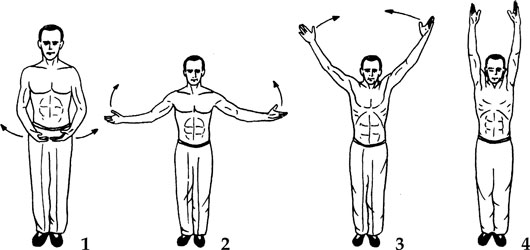
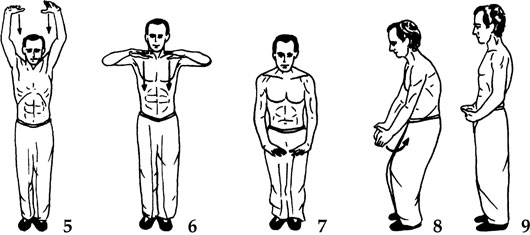
Fig. 38 Great Tai-Chi Circle:
1. Starting posture: heels together, toes splayed out at 30 to 45 degrees, palms facing upwards. 2. Inhale slowly while raising arms slowly out and up to the sides. 3. Continue inhalation while raising arms upward, keeping shoulders relaxed. 4. Stretch arms to the sky with palms facing each other and swallow upon completion of inhalation. 5. Turn palms to face the ground, relax shoulders completely, and slowly bring palms down along the front of body while slowly exhaling. 6. Continue exhalation smoothly while bringing palms down the front and slightly bending the knees. 7. Palms fully extended downwards in front and knees bent upon completion of exhalation. 8. Turn palms in and around towards the body while straightening the knees and taking a short inhalation. 9. Exhale after returning to starting posture, with brief intermission to check important points of posture before the next inhalation.
Benefits: Completely opens the Macrocosmic Orbit and stimulates energy flow through those channels. Balances Yin/Yang polarity and facilitates energy flow between left and right, top and bottom, front and back parts of the body. Gripping the ground with the big toes activates the liver meridian, drawing energy into the liver on inhalation. Provides a thorough stretch to the shoulders, ribcage, chest and abdomen, thereby enhancing deep diaphragmic breathing. Stimulates circulation of blood throughout the system. While opening the Macrocosmic Orbit of energy circulation, this exercise also amplifies circulation in the Microcosmic Orbit, drawing energy up the spine into the head on inhalation, then down the front into the lower abdomen on exhalation. It’s also an excellent exercise for developing focused attention and mental concentration in chi-gung, and for cultivating conscious awareness of chi moving through the body.
Cool-Down: Collecting and Storing Energy
It’s very important to conclude every chi-gung session with a few manoeuvres designed to collect and store energy, otherwise the energy harvested during the main practice can easily dissipate. Leaving too much energy lingering in the head and upper body after practice can also lead to problems, such as dizziness, headaches, irritability and insomnia. It only takes a few minutes to collect and store your energy in the lower elixir field centre below the navel, and down in the channels and bone marrow of the legs, so be sure not to overlook this important stage of practice.
Harmonizing Internal and External Energies (Fig. 39)
This exercise is designed to ‘wrap up’ energy lingering in the upper part of the body, both internally and externally, and to ‘pack’ it into the lower elixir field centre below the navel for storage. Regardless of which combination of chi-gung exercises you select for your main practice, you should always finish a session with this exercise, which is the first step in the collection and storage stage.
Method: Stand in Horse and bring the hands forward a bit, so that the palms are facing each other in front, with the lao-gung points perfectly aligned. As you commence inhalation, draw the hands apart and out to the sides, then slowly upward, always keeping the palm points aligned. When inhalation is complete and hands are spread out in front at about heart level, commence exhalation and slowly bring the palms, forearms and elbows together in a smooth movement, as though you were compressing a large balloon. When palms are about 8 inches (20cm) apart and exhalation is about half done, lower the hands and arms slowly down in front, until returning to the original position. Repeat 6 to 12 times.
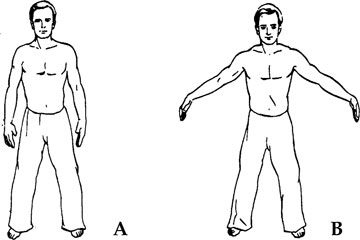
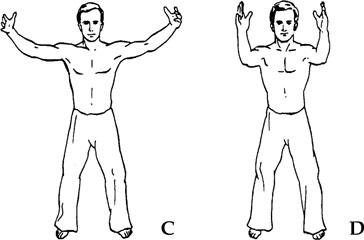
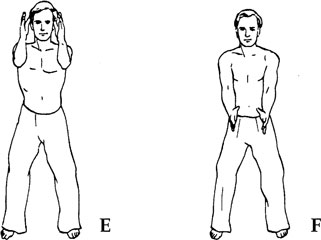
Fig. 39 Harmonizing Internal and External Energies:
A. Starting posture: Horse stance, hands extended in front with palms facing each other
B. Inhale slowly while drawing hands out to the sides in front, keeping the palms aligned
C. Arms raised and extended in front with palms facing upon completion of inhalation
D. Bring palms and forearms towards each other while exhaling slowly
E. When palms are head-width apart, bring them down slowly in front of body while continuing exhalation
F. Palms return to starting position upon completion of exhalation
After the last exhalation, continue to hold the hands out in front with palms aligned, about shoulder-width apart, close your eyes and continue deep abdominal breathing, drawing the hands a few inches further apart on the exhalation phase and bringing them closer together again on inhalation, like an accordion. Continue for 3 to 5 minutes.
Benefits: Collects energy from the upper parts of the body, internally as well as externally, condenses it, and draws it down the front into the lower elixir field centre for storage. Harmonizes the human energy field with external fields and balances polarity throughout the system. Moves energy through the lao-gung points in the palms, and helps cultivate conscious awareness of energy flow. Allows energy to settle naturally into the lower parts of the body.
Note: The latter part of this exercise (standing still with palms extended in front) is a form of still standing meditation and may be practised by itself any time of day or night. When practised at the end of a round of moving meditation, it helps settle energy and transforms some of it into spiritual vitality.
Head and Neck Rubdown (Fig. 40)
Method: Rub palms briskly together till warm, then place one palm on crown of head and rub down the back of the head, down the neck, and down along the side of the neck to the collarbone and chest in front. Follow the first palm immediately with the other one, alternately rubbing down the head and neck and sweeping around the sides to the front and down the chest.
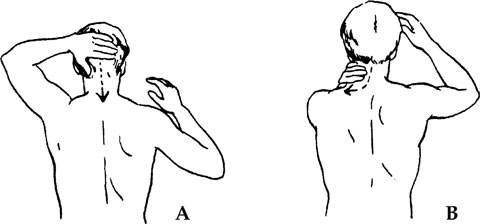
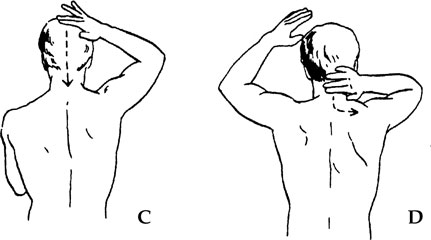
Fig. 40 Head and Neck Rubdown:
A. Rub head down from the crown to back of the neck
B. Continue sweeping down along side of neck, while starting to rub down from crown with the other hand
C. Continue sweeping down with second hand
D. Bring first hand back to crown for next rubdown
Benefits: Sweeps excess energy from the head and neck and draws it into circulation down the front of the body, settling it into the lower elixir field below the navel. Activates lymph in the neck and stimulates blood circulation in the scalp.
Tapping the Celestial Drum (Fig. 41)
Method: Rub palms together till warm, then place palms firmly over the ears, creating an air-tight seal, with fingers against back of skull. Hook index fingers over middle fingers and snap them against the back of the skull, at the ‘Wind Pond’ points where the neck ends and the skull begins (see “Feng-chih [‘Wind Pond’]”). Snap repeatedly, creating a drumming sound within the skull, 36 times.
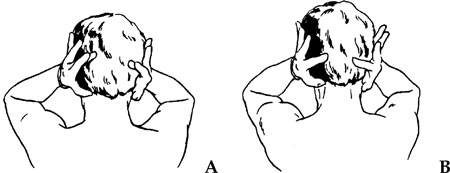
Fig. 41 Tapping the Celestial Drum:
A. Hook index fingers over middle fingers
B. Snap index fingers against back of skull
Benefits: Helps clear excess energy from the skull. Vibrations stimulate the pineal and pituitary glands and help balance right and left hemisphere functions. Clears mental static from the brain, preparing the mind for still meditation after a round of moving exercises.
Body Sweep
Method: Rub palms together till warm. Use left palm to sweep down the right arm, from the shoulder down the outside of the arm to the fingers, then from shoulder down the inside of the arm to the fingers. Do the same on the other arm using the other hand. Rub palms together again, and use them to rub down the chest from the throat to the navel, then down the ribcage from the armpits to the hips.
Benefits: Draws excess energy down from the top of the body, sweeping it out to the hands and down into the lower abdomen. Stimulates microcirculation in the skin. Enhances the protective shield of Guardian Energy.
Kidney Rubdown
Method: Rub palms together till warm. Place palms on kidneys and rub gently.
Benefits: Draws energy down into the kidneys and adrenal glands and condenses energy there. Stimulates adrenal secretions and boosts immunity.
Leg Channel Tap (Fig. 42)
Method: Rub palms together till warm, then roll fingers into fists, with thumbs clenched against the outsides of index fingers. Use the curled knuckles and base of palms to vigorously tap down the outsides of the legs, from hips down to ankles and back up again, three times. Then do the same on the inside surface of the legs, from the groin to the ankles. This may be done stooped forward in the standing position, or sitting on a stool.
Benefits: Drives energy accumulated in the legs into the reservoirs of the leg channels, and into the marrow of the leg bones. Leg channels serve as storage centres for sexual energy and general physical vitality, while marrow produces white and red blood cells. When fresh energy is tapped into the marrow, it purifies the marrow and stimulates production of new blood cells.
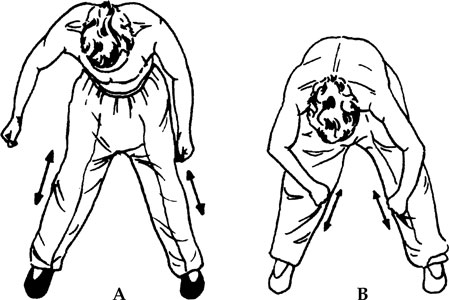
Fig. 42 Leg Channel Tap:
A. Tap up and down the outside of the legs from hips to ankles
B. Tap up and down the inside of the legs from crotch to ankles
Navel Rub: Closing the Energy Gates (Fig. 43)
Method: Rub palms together till warm. Place one palm on the navel, with the lao-gung point directly over the navel. Place the other palm over the first, then gently rub in small circles, 2 to 3 dozen times.
Benefits: This manoeuvre, which closes the energy gates, draws energy from the entire system down into the navel region for storage and seals the lower elixir field so that the energy collected there does not leak out. It also stimulates gastrointestinal secretions and balances digestive functions. It harmonizes the entire energy system and develops conscious awareness of the lower elixir field as the centre of balance and major storage depot for energy.
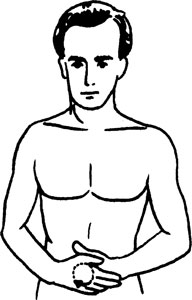
Fig. 43 Navel Rub: Closing the Energy Gates
Thanking the Universe and All Teachers of Truth (Fig. 44)
This is the proper way to conclude any type of internal energy or spiritual work in Asian traditions and is somewhat akin to saying grace before a meal in Western tradition. Indeed, some practitioners make a similar gesture before as well as after a practice session, and in some schools it is customary to bow to all four points of the compass as a symbolic acknowledgement to the entire universe. Its purpose is to acknowledge the greater wisdom and power of the universe, and of those who have mastered that wisdom and power and teach others how to discover it, and to express personal gratitude for whatever was gained during the preceding practice session. In addition to thanking the universe itself, this is also a gesture of respect to all true teachers who have helped transmit the wisdom and power of the universe to humanity. This includes whoever teaches you, as well as your teacher’s teacher, and all the teachers in that lineage, plus all teachers who ever taught anyone anywhere, who you regard as sacred, such as Jesus, Buddha or Lao Tze.
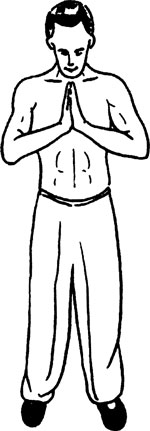
Fig. 44 Thanking the Universe and All Teachers of Truth
Method: After completing the final step in your practice, place your palms together before your heart, bow your head slightly, and silently thank your teachers, their teachers and all teachers of truth, as well as the whole universe, for sharing their wisdom and power with you, and resolve to share what you have gained with others.
Benefits: While this may seem like a mere formality, it can in fact have a profound influence on your practice. After a session of chi-gung, your entire system is very closely interlinked with the energy and awareness of the universe, with the spirits of your teachers, and with any other spiritual entities you personally hold as sacred. Consciously acknowledging their presence and expressing gratitude for the benefits of their wisdom, compassion and power forges a strong connection between your spirit and theirs, and this creates a channel of direct mind-to-mind transmission in your practice. This gesture also helps prevent the hubris that sometimes arises as a result of successful practice, by acknowledging the universe as the ultimate source of all virtue, not your own ego, and seeing yourself as a vessel into which the wisdom and power of the universe pours, like lustral water into a vase.
Still Meditation
Still forms of chi-gung may be practised in one of the sitting postures (see Figs. 12 and 13), or else standing in the Horse stance (see Fig. 11) with the palms held shoulder-width apart in front facing each other (Fig. 49a) or extended out to the sides facing forward (Fig. 49b). Still and moving meditations are the Yin and Yang of chi-gung forms, and when practised together the effects are highly synergistic and complementary. Both styles of practice mobilize internal energy and balance the human energy system. However, moving forms focus more on the interaction of energy and essence and the synchronicity of body and breath, while still forms engage energy and spirit and work more with the union of mind and breath. Moving exercises are therefore the most beneficial form of practice for cultivating physical health and longevity, while still forms are best for cultivating mental clarity, spiritual awareness and a tranquil state of mind.
When practised together, still meditation is usually done after the moving set, in which case there is no need to prepare body and breath with preliminary warm-up exercises, because both will already be in balance as a result of the moving exercises. When still meditation is practised separately, such as late at night, it’s best to first prepare your system for it by balancing body, breath and mind with the following preliminary steps.
Balancing Body and Breath for Still Meditation
• Body. First do 2 to 3 minutes of the ‘spinal twist’ warm-up introduced earlier in this chapter (see “Warm-Up: Balancing Body, Breath, and Mind for Practice”), then do 2 to 3 minutes of the following ‘serpentine’ spinal stretch exercise (Fig. 45). Sit cross-legged on the floor or on the edge of a chair with hands palm-down on the knees. Jut the chin out in front and lean forward, leading the body with the head and stretching the spine. When fully extended forward, tuck the chin down, arch the spine and raise the torso back up to the erect sitting position by pushing the hands against the knees and straightening up the spine from the coccyx to the neck. Repeat at a fairly brisk pace for 2 to 3 minutes. This exercise stretches the spine, aligns the vertebrae and stimulates the nerves of the spinal cord. It opens the two major channels of the Microcosmic Orbit circuit in front and back, as well as the central Thrusting Channel that links the energy gates on the crown of the head with the lower elixir field in the abdomen. These are the three most important channels for internal energy circulation in still meditation. It also tones the muscles of the spine to help maintain correct posture during practice.
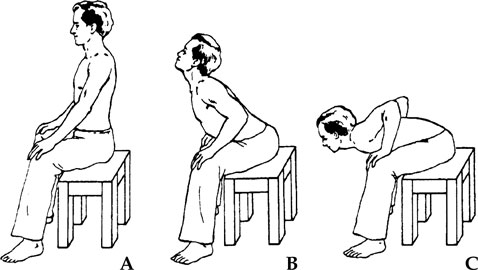
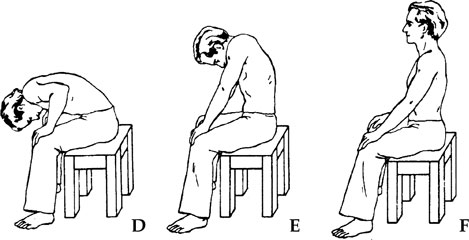
Fig. 45 The Spinal Stretch:
A. Starting posture: hands on knees, spine erect
B. Lean forward, leading with the chin and bowing the spine
C. Extend fully forwards and stretch the spine
D. Tuck the head down and arch the spine up, pushing up on hands
E. Push body back up to erect posture and raise up the neck while straightening the spine
F. Return to starting posture
• Breath. While sitting or standing in proper posture, do a minute or two of incremental bellows breathing to clear the lungs, loosen the diaphragm, oxygenate the bloodstream, and eliminate carbon dioxide and other wastes. Then do 6 to 8 rounds of ‘Clear Head Cool Heart’ breathing (Fig. 46), as follows: Inhale deeply and slowly through the nostrils, while slowly raising the head up and tilting it back and arching the neck and upper spine, until fully extended. Then open the mouth and commence a long slow exhalation, making a ‘haw’ sound at the top of the throat, while bringing the head forward and down and tucking the chin against the chest as exhalation is completed. Inhale and raise the head up and back again, repeating 6 to 8 times. This exercise purges excess Fire energy from the lungs and heart, thereby cooling and calming the respiratory and circulatory systems for still meditation. It also clears the brain, releases tension in the neck and shoulders, and activates energy circulation along the spinal channels into the head.
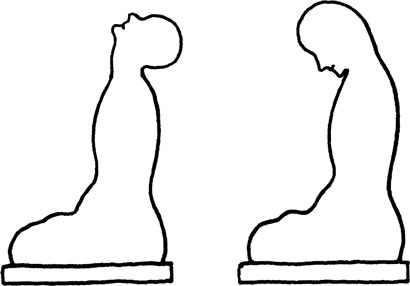
Fig. 46 ‘Clear the Head, Cool the Heart’ Breath:
A. Inhale and raise head up and back as far as possible
B. Exhale and lower head forward and down as far as possible
• Mind. After completing the manoeuvres outlined above, do a few minutes of alternate nostril breathing. Not only does this further balance the breath, it also balances the right and left hemispheres of the brain, induces a state of mental equilibrium, and allows the intuition and insight of the right hemisphere to function in conjunction with the rational thought and linear logic of the left.
Finally, take a deep inhalation, then open the mouth and throat wide and sound the tone ‘ahh’ in a long steady stream until the lungs are completely empty. Repeat 3 times. This tone opens the throat chakra, which governs breathing and houses the spiritual faculties involved with perceiving and expressing truth. Sounding this tone before still meditation helps prepare the mind to receive any messages or insights that the universe (‘Heaven’) may bestow during a session.
Sitting Meditation
There are many different styles of meditation in the spiritual traditions of Asia, each of which has its own tutelary deities, patron saints, sacred scriptures and divine revelations for disciples to work with in their contemplative practices. Since this book focuses on chi-gung as a means of working with energy, and since meditation is a form of chi-gung in which energy is used to nurture spirit and spirit is focused to regulate energy, we will limit our discussion here to ways of working with energy for spiritual purposes and working with spirit to cultivate energy. This is the Taoist approach to meditation – a non-sectarian and non-theistic path of practice that may be applied to any spiritual tradition in the world, without conflicting with any theoretical doctrines and religious beliefs.
One of the primary goals of Taoist meditation is simply to clear the mind of discursive thought and mundane distractions and restore it to a pristine state of open clarity and silent calm, so that we may recover our inherent link with the infinite awareness of the universe. As the Tang dynasty grand master of the Complete Reality School of Taoism, Lu Tung-pin, puts it: ‘The mind is primordially pure and calm, completely free and infinitely vast . . . Therefore, managing the mind simply means maintaining it in its original state of purity, clear as mountain water, fresh and uncontaminated, silent as a huge valley, without distraction, immeasurably vast, wide open as the sky, without boundaries.’ The point of this practice is not just to sit still for a while each day, then return to our normal state of mental distraction, but rather to cultivate stillness of mind throughout the day. ‘True sitting,’ writes the Sung dynasty master Wang Che, ‘means that the mind is as still as a mountain at all times, regardless of what you are doing, in activity as well as repose . . .’
What people who don’t meditate don’t realize is that meditation has very practical benefits for health and longevity as well as for spiritual cultivation, and this is particularly true of Taoist meditation, which cultivates the fundamental energy of life. The Taoist classic, Huai-nan-tze, states:
Whatever can be achieved internally may also be attained externally. When one masters the internal, the vital organs are in perfect harmony and the mind is calm . . . When one reposes in blissful serenity and remains undisturbed by habitual attachments, then the vital organs will rest in harmony, suffused with energy that does not leak. Thus, the spirit protects the body internally without roaming abroad.
Mental and emotional stress squanders energy faster than even the most gruelling manual labour. Not only does stress damage the organs and impair immune response by causing secretions of hormones that put the entire system on perpetual ‘fight or flight’ alert, it also causes a constant leakage of energy due to the worry and emotional turmoil it triggers. Meditation is the most effective antidote against stress, and with prolonged practice, meditation trains the mind not to re-act to stressful situations with the ‘fight or flight’ response, by cultivating the virtues of detachment and emotional equanimity.
What distinguishes Taoist meditation from all other traditions is the internal alchemy of the Three Treasures, which integrates body and mind with energy. As Chang San-feng, the founding father of Tai Chi Chuan, notes, internal alchemy ‘enables the spirit to guide energy, and energy to sustain the body. At this stage, one no longer requires complicated exercises and other techniques in order to achieve longevity.’ In other words, when you reach the stage of practice where you can manage your energy directly with your mind through internal alchemy, then meditation becomes the only practice you need to achieve health and longevity, and even physical exercise is no longer necessary, since you will be able to ‘exercise’ your body with your mind via its complete command over energy. But please don’t think that you can abandon exercise, diet, supplements, sexual discipline and other techniques after only a few days of meditation practice. It takes many years of disciplined practice to reach that stage of self-mastery, and until then, all of the various exercises and other physical techniques involved in the ‘Tao of Cultivating Life’ remain important stepping stones on the path of practice.
A variety of traditional Taoist meditation techniques are described in the author’s previous books, so here we will simply run through a typical meditation session together, working with the central Thrusting Channel, the Microcosmic Orbit (Governing and Conception Channels), the energy gate on the crown of the head, and some of the major ‘passes’ that relay energy along the Microcosmic Orbit. Fig. 47 outlines the major paths of energy flow in this meditation.
Adopt a comfortable sitting posture, either cross-legged on the floor with a cushion to elevate the pelvis and support the spine, or else on the edge of a low stool or chair. If you have not practised a moving meditation set prior to sitting, then prepare yourself first with the preliminary steps introduced above.
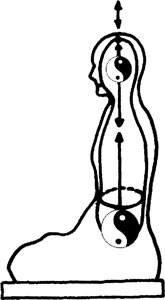
Fig. 47 Major Energy Paths in Taoist Meditation: Governing, Conception, Thrusting and Belt Channels; Upper and Lower Elixir Fields
Rest your hands separately on top of the thighs, palms up, close your eyes, and spend the first few minutes of practice working exclusively with your breath. Follow the flow of air in and out of the nostrils, focus attention on the four stages of breathing, and gently apply the three locks to stimulate circulation of blood and energy and harmonize the internal organs. When breath is flowing smoothly and the body feels balanced and stable, shift your attention away from the four stages and three locks of breath control and simply let your breathing function naturally, with the abdomen expanding and contracting with the rise and fall of breath.
Now shift attention to the top of the head and visualize a column of clear white light streaming in on inhalation and travelling down the central Thrusting Channel to the lower elixir field centre just below the navel, where it collects and forms a radiant globe of bright light. Or you might prefer to visualize the energy forming a pool of liquid light below the navel. On exhalation, let the energy in the globe or pool condense and grow brighter. Inhale and draw more luminous energy down through the crown, feeling the throbbing sensation at the gate as it enters and following it down the central channel into the lower elixir field. Try not to lose sight of this light in your mind’s eye: enhance the visualization with every breath by focusing attention on its colour and luminosity and any other distinctive qualities it may manifest. For you, it may look white or golden, blue or pink, peach or purple; it might feel warm or cool, wet or dry, smooth or vibrant. Don’t try to dictate its appearance: just see and feel it as it comes to you and let your mind’s eye witness its activity.
After a week or so of daily practice, the ‘Sea of Energy’ in the lower elixir field will grow full, and the energy collected there will be ready to flow down to the base of the spine and enter circulation in the Microcosmic Orbit via the coccyx, the first pass of the Governing Channel, which draws energy up the spine into the upper elixir field in the head. Focus on the feeling of energy moving in the sacrum for about a week, until the lower pass opens, then let the energy rise naturally up to the next pass, which is the Gate of Life, located along the spine directly behind the navel. Every time you sit down to practise this meditation, start from the beginning at the crown of the head, follow the energy down into the lower elixir field, watch it grow and glow there, then let it brim over and flow down into the coccyx, until it reaches the point to which it progressed last time, and spend the rest of the session working up from that point.
Master Han Yu-mo, who teaches Taoist internal energy meditation in Taiwan, has developed an eight-week programme of practice that focuses entirely on opening up and expanding the Microcosmic Orbit circuit of energy circulation (Fig. 48). So let’s follow his method by quoting some excerpts from his booklet, Directions for Meditational Techniques, translated by myself and Ronald Brown and published in 1994, in Taipei. This booklet may be ordered directly from Master Han’s meditation centre (see Appendix). Here’s how it works:
• First week. Working with the ‘Medicine Palace Gate’
This is the gate through which primal spirit passes in and out of the body, and the major entry point for psychic energy. It is located midway between the crown of the head and the hairline. Visualize yourself as a gourd-shaped vase with its mouth located on top of your head, and slowly draw psychic energy into your body through this opening. After practising this for 3 to 5 days, you will begin to feel a sort of pressure on this spot, or an itchy sensation as though ants were crawling around the roots of your hair at this point. This feeling indicates that this energy gate has begun to open.
• Second Week. Working with the ‘Great Sea of the Elixir Field’
This point is located 2 inches (5cm) below the navel, midway between the abdominal wall and the spine. It is the foundation of all internal energy practices. Visualize yourself as a gourd-shaped vase, with the base located at the Elixir Field, and imagine the interior of the vase embracing a Great Sea of energy . . . Slowly draw energy down into this area as you breathe . . . There will be a feeling of warmth there that continues unabated as you sit. This indicates that the Elixir Field is gradually taking shape and filling with energy.
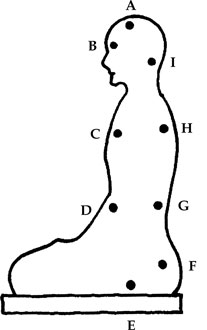
Fig. 48 Major Power Points in the Microcosmic Orbit Internal Energy Meditation:
A. ‘Medicine Palace’ point on the crown
B. ‘Celestial Eye’ at the Upper Elixir Field
C. ‘Central Terrace’ at the heart
D. ‘Sea of Energy’ at the Lower Elixir Field
E. ‘Confluence of Yin’ at the perineum
F. ‘Tail End’ at the coccyx
G. ‘Gate of Life’ between the kidneys
H. ‘Great Hammer’ between the shoulders
I. ‘Jade Pillow’ at junction of neck and skull
• Third Week. Working with the ‘Hole at the Bottom of the Sea’
Located at the tip of the coccyx at the bottom of the spine, this point is where energy drains down from the Great Sea of the Elixir Field when it is full of energy. It is also the gate into the Governing Channel, which runs from the coccyx up to the head. After packing energy into the Elixir Field for 2 or 3 weeks, the Great Sea will brim over with energy, which will then automatically drain down into the Hole at the Bottom of the Sea and thereby enter the gate of the Governing Channel. It will cause a feeling of warmth, pressure and tingling there, as well as a sensation of upward thrusting.
• Fourth Week. Working with the ‘Gate of Life’
The Gate of Life is located directly behind the navel along the spine. It is the first major power point along the Governing Channel. After sitting in meditation for a while and moving energy from the Elixir Field down into the Hole at the Bottom of the Sea, the energy will automatically rise up to the Gate of Life point, without any conscious effort. When energy reaches this point, it feels as if a patch of pure energy were stuck on to the skin at this point. There will also be very concrete sensations of heat, cold and tingling here.
• Fifth week. Working with the ‘Great Hammer’
The Great Hammer is the point where the horizontal and vertical axes of the skeleton intersect, like the central point on a cross. It is the second major power point along the Governing Channel. After sitting in meditation for a while, energy will naturally flow upward from the Gate of Life to this point. There will be a hot, swollen tingling sensation of pressure here, as if a square patch of cloth were firmly adhered to this area. There will also be feelings of energy rising and falling. After several weeks of practice, energy will enter and exit this point according to the body’s needs.
• Sixth Week. Working with the ‘Mysterious Gate’
The Mysterious Gate is the point from which a person’s primordial Yin spirit (‘spiritual embryo’) enters and exits the body in highly advanced meditation. It is located midway between and slightly above the eyes. When the three major power points along the Governing Channel are filled with energy, energy will automatically rise up over the head and gather at the Mysterious Gate. The Mysterious Gate is the other point through which psychic energy may be drawn into the body. When one’s meditation practice has reached this stage, one may switch over to this point for absorbing psychic energy from Heaven and Earth.
• Seventh Week. Working with the ‘Yellow Court’
Located in the centre of the chest, the Yellow Court is the central circuit intersection for the body’s autonomous breathing process and the first major power point along the Conception Channel, which runs from the head down the front of the body to the perineum. One may now draw psychic energy into the system through either the Medicine Palace Gate or the Mysterious Gate. Energy will be felt descending to this point from the forehead, Mysterious Gate, nose, mouth and palate. It will feel as if ants were crawling up and down just below the skin at this point.
• Eighth Week. Working with the ‘Belt Channel’
The Belt Channel revolves completely around the waist at the level of the navel. When energy moves here, it is the first clear sign that the Microcosmic Orbit formed by the Governing and Conception Channels has been completely opened and filled with energy. When energy circulates here, the skin will feel as if ants were crawling around just beneath the surface.
The best times to practise still sitting meditation are during the hours around dawn and midnight, and any time in between midnight and dawn, when Yang energy rises, ascends and peaks. Some people get up in the middle of the night especially to practise this meditation, then go back to sleep afterward. Each meditation session should last from 20 to 45 minutes. Longer sessions tend to be counterproductive, because blood circulation often gets obstructed in the legs and lower back, which in turn blocks energy, while shorter sessions do not provide enough time for body, breath and mind to settle into the state of balance and harmony required for the human energy system to assimilate subtle energies from the universe and circulate them through the Microcosmic Orbit. It’s also important to practise daily, so that the gates and channels remain open and active.
The term ‘psychic energy’ refers to highly refined forms of universal free energy which can awaken primordial awareness when assimilated into the human system during meditation practice. This energy is ever-present in the environment, but for most people, it’s like ‘water off a duck’s back’, because this energy can only enter the human system if the gates and channels that transmit it are open and functioning, and this can only be achieved through meditation practice.
This energy not only awakens spiritual awareness, but it may also be transformed in the chakras for other uses, such as healing, creativity, physical vitality and so forth. As the highest energy in the universe, its potency includes all the functions of the lower energies, and it may therefore be utilized to support all the basic functions of life. Furthermore, since this is the omnipotent energy associated with spirit, and since ‘spirit commands energy and energy commands essence’, this energy may be transformed by the spiritual faculties of visualization and intent to produce any type of essence required by the body. In other words, if your practice is sufficiently developed, you may literally ‘feed’ yourself simply by assimilating and storing abundant supplies of this energy and converting it as needed to repair cells, produce blood, generate heat and so forth.
This is the method that sustains yogis through 200-day fasts in the Himalayas, the principle in the bi-gu regime of periodic abstention from food practised by Taoists, and the way that so-called ‘breatharians,’ who give up all food permanently, continue to live long and healthy lives without eating. It may be difficult for people whose stomachs start growling with hunger the moment they wake up in the morning to imagine going even two days, much less two hundred, without food, but a hundred years ago it was equally difficult for people to imagine sitting in a machine that flies them through the air at 600 mph. The point is that like aerodynamics, the dynamics of internal energy work involved in sustaining physiological life solely by breath are based on scientific principles of universal validity, and they may be learned and mastered by anyone who is willing to put them into practice.
Before ending a meditation session, it’s a good idea to dissolve whatever visualizations you’re working with, close your mind’s eye, and simply rest for a few minutes in the primordial state of emptiness, luminosity and energy, thereby cultivating awareness of the ‘shining pearl’ of immortal spirit which ‘is not born and does not die’. According to Hindu, Buddhist and Taoist views, the fundamental state of the entire universe, as well as that of every being in every dimension of existence, has three essential natural qualities:
• ‘Empty’. This means that everything in the universe is essentially immaterial, empty of permanent concrete form, and that all material things are therefore impermanent and illusory, and ultimately ‘unreal’. Thus, the physical body is essentially nothing more than a swirling vortex of organized energy temporarily bound in space and time, and therefore, like all forms of composite matter, the body of flesh, blood and bone will ultimately dissolve and disappear. Only spirit, which is immaterial, is real and permanent, transcending the temporal limits of space and time, and therefore only spirit can survive death and realize the immortal state of existence.
• ‘Luminous’. The essential emptiness of the universe and the spirit is not like a dark void or ‘black hole’ in space. It shimmers with self-existent luminosity, a shining radiance that does not depend on light reflected from the stars. That brilliant luminosity is the natural glow of awareness. It is the inherently radiant nature of the creative intelligence at work behind the constant interplay of form and emptiness and the ceaseless transmutations of energy and matter that give rise to the manifest universe and ‘make the world go round’. In the microcosm of the human system, the same luminosity radiates from the eternal flame of consciousness that glitters within the spirit of each and every being in the universe.
• ‘Energy’. This essentially empty, naturally radiant ground of primordial spirit is suffused with unlimited energy of infinite potential. This energy is the basic ‘stuff’ of the universe, the immaterial material from which all form and matter arise and into which all composite matter again dissolves. This self-existent energy is governed by the luminous light of awareness and responds immediately to the beck and call of the creative spirit that permeates the entire universe.
In a nutshell, our world and everything and everyone in it, as well as all worlds everywhere, ultimately boil down to luminous empty space suffused with infinite energy, and these three essential qualities – immaterial emptiness, luminous awareness, and infinite energy – are the common denominators in all equations of life and throughout all existence in the universe. The only prerequisites for spiritual immortality are conscious awareness of these three basic facts of life, and conscious application of these facts as a basis for one’s daily behaviour and point of view. When the reality of these three facts is truly understood, enlightened awareness dawns spontaneously, and spiritual immortality is attained. This is the ultimate goal of all spiritual practice, and reaching that goal is the only truly valid reason for preserving the health and prolonging the life of the physical body. Therefore, it’s a good idea to conclude each meditation session with a brief plunge into the universal ocean of emptiness, awareness and energy, the primordial state of immortal existence that precedes birth and survives death and never ceases for a single instant, just to remind yourself that where you’re going is precisely where you came from.
Standing Meditation
Still meditation may also be practised in standing postures. This is also a convenient way to do a bit of still meditation immediately after finishing a set of moving exercises, particularly after completing a round of the energy-collection exercise called ‘Harmonizing Internal and External Energies’ (see Fig. 39), which puts you in the correct posture for standing meditation.
Still standing meditation moves energy somewhat differently from sitting meditation. In addition to opening the Microcosmic Orbit, it also extends energy circulation through the main channels of the legs and arms, thereby opening all eight channels of the Macrocosmic Orbit. In the sitting posture, external energy enters the system primarily through the Medicine Palace Gate on top of the head, but in standing, it also flows in through the Labour Palace Gate on the palms and the Bubbling Spring Gate on the soles. Standing practice therefore works with a wider range of terrestrial and celestial energy frequencies than sitting, which works primarily with the highest forms of energy associated with spiritual awareness.
In the standing postures, there is a greater distance and therefore a greater potential gradient factor between the Yang pole on top of the head and the Yin pole on the bottom of the feet, compared with the sitting position, in which the base of the spine forms the ground terminal. Energy therefore moves with more dynamic force in the standing position, which is a good way to boost vitality and energize the body but which can also distract attention from the more subtle aspects of spiritual work. Sitting postures draw awareness more deeply into the internal alchemy of energy and spirit in the chakras and major passes of the Microcosmic Orbit, whereas standing meditation focuses more attention on circulation of energy through the entire Macrocosmic circuit and thereby enhancing physical power. Standing meditation also pumps up the external shield of Guardian Energy which protects the body from invasion by negative environmental energies, deviant forces and malevolent entities and increases resistance to the external causes of disease.
It’s a good idea to practise both styles of still meditation – standing and sitting – to familiarize yourself with the relative benefits of each. Standing is probably more beneficial to physical health and longevity, but sitting is definitely the best way to cultivate internal energy for spiritual work and develop primordial spiritual powers, such as clairvoyance and clairaudience.
The two main standing positions for still meditation are illustrated in Fig. 49, A and B. In the first one, feet should be exactly shoulder-width apart and parallel, as in the classic Horse stance (see Fig. 11) used for moving meditation. After rubbing palms together till warm, hold hands slightly raised in front, elbows bent, with the lao-gung points on the palms precisely aligned facing each other. Eyes may either be kept closed, or else half-open, gazing unfocused into the space between the palms. Preliminary preparation of body and breath is the same as in sitting practice, but this may be skipped if you’re practising immediately after a set of moving exercises. In addition to working with the energy gates on the head, this position also opens the gates on the palms and soles. For example, you may bring energy in through the crown, draw it down to the lower elixir field, and channel it out through the palms, thereby creating an increasingly powerful force field between the hands. You can also try drawing earth energy up through the Bubbling Spring gates on the feet and moving it into general circulation through the Microcosmic Orbit, or out through the palms. Or you might try working exclusively with the palm points by ‘breathing’ through them, drawing them closer together on inhalation and farther apart on exhalation, and focusing attention on the sensations produced by energy moving through the hands and arms. Another method is to feel the whole energy field around your body expanding and contracting on inhalation and exhalation, which is a good way to fortify your shield of Guardian Energy. Energy is always present in and around the human system, but where it goes and how it acts in the system depends entirely on how your mind chooses to work with it.
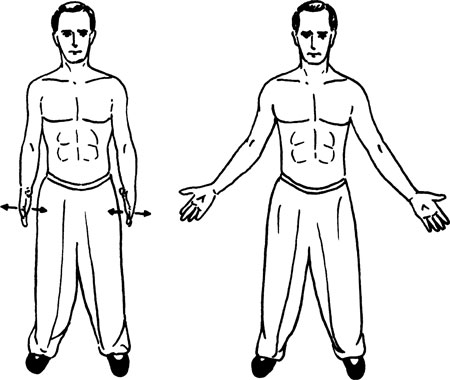
Fig. 49 Postures for Standing Meditation:
A. Horse stance, with hands extended slightly in front, palms facing
B. Wider Horse stance, with hands extended slightly out to the sides, palms facing forwards
The other standing position requires a slightly wider stance, with the feet splayed outward at a 45-degree angle and the hands, which should first be charged by briskly rubbing the palms together, raised slightly up and out to the sides, with palms facing forward and fingers relaxed. Avoid locking the elbows and knees so that energy may flow freely through them. While the first standing posture, in which the palms face each other, recirculates energy drawn from external sources, this posture focuses more on the exchange of energy between the human system and the external environment. Therefore, when using this posture, be sure that the external source with which you are exchanging energy generates pure, potent positive energy, not polluted negative energy. For example, meditating in this posture is a very good way to exchange energy with an ocean, a mountain, a valley, a forest, a sacred temple, a pristine waterfall, a huge old tree and other natural founts of pure energy. Simply stand there facing the external energy source, with the lao-gung points aimed directly at it, and breathe through the palms. After a while, you may also try to open the Mysterious Gate point between the brows and draw energy in through that gate as well.
Collection and Storage
As in moving meditation, it’s important to collect and store energy in the lower elixir field after still practice (see “Cool-Down: Collecting and Storing Energy”), although in still chi-gung, you don’t need to invest as much time and effort in this phase of practice, because still meditation naturally collects and stores energy in the lower elixir field.
After finishing a session of sitting or standing meditation, simply rub the palms together and sweep down the back of the head and neck, then place them on the kidneys and rub gently for a minute, and finally wrap it all up and close the gates with the navel rub. Conclude with a bow of gratitude to the universe and a vow to share whatever power and wisdom you may have gained with others.
All of this may seem easier said than done but, in fact, when it comes to the internal alchemy of working with energy and spirit in still forms of chi-gung, it’s a lot easier done than said. That’s because in still practice we’re dealing with very subtle energies and faculties of awareness that lie beyond the realm of words and beyond the boundaries of temporal space and time. The only way to engage in this work is to discard words and concepts and operate entirely through intuition, intent and insight. Intent is a Yang faculty of spirit which mobilizes, transforms and guides energy through the system, while intuition is a Yin faculty of spirit through which subtle energies and higher levels of awareness may be felt and spontaneously understood. Even if you are not consciously aware of what’s happening while you practise, as long as you set the process in motion with clear intent and careful application of the basic principles, the practice will work for you and deliver positive results. As in any kind of work, persistence pays in energy work and spiritual practice, and before long, your mind’s eye will learn to see the radiance of universal energy in the luminous light of primordial awareness, and your heart will feel your ancient links with the eternal wisdom, boundless compassion and infinite power of the universe reawaken and blossom.